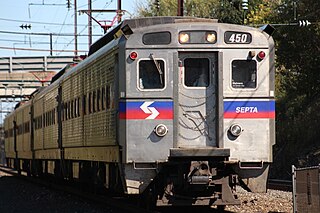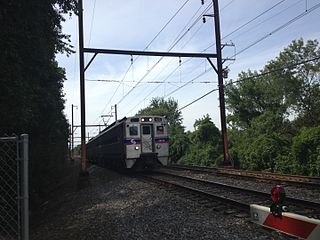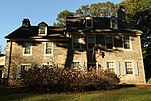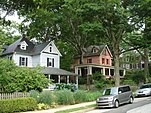
The SEPTA Regional Rail system is a commuter rail network owned by SEPTA and serving the Philadelphia metropolitan area. The system has 13 branches and more than 150 active stations in Philadelphia, Pennsylvania, its suburbs and satellite towns and cities. It is the sixth-busiest commuter railroad in the United States, and the busiest outside of the New York, Chicago, and Boston metropolitan areas. In 2016, the Regional Rail system had an average of 132,000 daily riders and 118,800 daily riders as of 2019.

The Atlantic City Line (ACL) is a commuter rail line operated by NJ Transit (NJT) in the United States between Philadelphia, Pennsylvania and Atlantic City, New Jersey, operating along the corridor of the White Horse Pike. It runs over trackage that was controlled by both the Pennsylvania Railroad (PRR) and the Pennsylvania-Reading Seashore Lines. It shares trackage with SEPTA and Amtrak on the Northeast Corridor (NEC) until it crosses the Delaware River on Conrails Delair Bridge into New Jersey.

The Keystone Corridor is a 349-mile (562 km) railroad corridor between Philadelphia and Pittsburgh, Pennsylvania, that consists of two rail lines: Amtrak and SEPTA's Philadelphia-to-Harrisburg main line, which hosts SEPTA's Paoli/Thorndale Line commuter rail service, and Amtrak's Keystone Service and Pennsylvanian inter-city trains; and the Norfolk Southern Pittsburgh Line. The corridor was originally the Main Line of the Pennsylvania Railroad.

The Trenton Line is a route of the SEPTA Regional Rail system. The route serves the northeastern suburbs of Philadelphia, Pennsylvania with service in Bucks County along the Delaware River to Trenton, New Jersey.

The Wilmington/Newark Line is a route of the SEPTA Regional Rail commuter rail system in the Philadelphia area. The line serves southeastern Pennsylvania and northern Delaware, with stations in Marcus Hook, Pennsylvania, Wilmington, Delaware, and Newark, Delaware. It is the longest of the 13 SEPTA Regional Rail lines.

Jenkintown–Wyncote station is a major SEPTA Regional Rail station along the SEPTA Main Line in Montgomery County, Pennsylvania. It is located at the intersection of Greenwood Avenue and West Avenue on the border of Jenkintown borough and the Wyncote neighborhood of Cheltenham Township, with a mailing address in Jenkintown. It is the ninth-busiest station in the regional rail system, and the fourth busiest outside Center City. Despite this, the station is not wheelchair accessible. SEPTA had plans to make the station wheelchair accessible by 2020, but these have not yet been completed.

Bethayres station is a SEPTA Regional Rail station in Bethayres, Pennsylvania. It is located at Station Avenue and Old Welsh Road and serves the West Trenton Line to Ewing, New Jersey. Bethayres station was originally built in 1876 by the Reading Railroad. The station has off-street parking and a ticket office. There is also a handicapped-accessible platform. In FY 2013, Bethyares station had a weekday average of 578 boardings and 553 alightings. Bethayres is the last boarding stop for AM peak service express trains to Philadelphia and the first discharge stop for PM peak service express trains from Philadelphia.

Yardley station is a SEPTA Regional Rail station in Yardley, Pennsylvania. It is located at Main Street and Reading Avenue and serves the West Trenton Line to New Jersey. The station has off-street parking. In FY 2017, Yardley station had a weekday average of 349 boardings and 328 alightings. By August 2015, as a result of the SEPTA and CSX separation between Woodbourne and West Trenton stations, the outbound platform was removed, and all SEPTA traffic was diverted onto the Inbound track. Currently, all SEPTA service between Yardley and West Trenton operates on the Inbound track only.

The Trenton Subdivision is a railroad line owned by CSX Transportation in the U.S. states of Pennsylvania and New Jersey. The line runs from CP NICE in Philadelphia, Pennsylvania, northeast to Port Reading Junction in Manville, New Jersey, along a former Reading Company line.
The West Trenton Line is a proposed NJ Transit (NJT) commuter rail service that would be operated mostly on the CSX Transportation Trenton Subdivision, connecting West Trenton Station in Ewing Township, New Jersey with Newark Penn Station in Newark, New Jersey. The route would connect with the Raritan Valley Line at Bridgewater and the SEPTA West Trenton Line at West Trenton. As of 2007, NJT's estimate of the cost of creating a passenger line to West Trenton was $219 million. The project is still on the books, but no funding for the proposal has been secured to this date.

The Crusader was a 5 car stainless steel streamlined express train that ran on a 90.3-mile (145.3 km) route from Philadelphia's Reading Terminal to Jersey City's Communipaw Terminal, with a ferry connection to Lower Manhattan at Liberty Street. The Reading Railroad provided this service in partnership with the Central Railroad of New Jersey (CNJ), in which it was the majority owner of capital stock. Trains including the Crusader ran on Reading Railroad tracks from Reading Terminal in Philadelphia to Bound Brook, NJ, where they continued on CNJ tracks to Communipaw Terminal in Jersey City. Passengers then left the train and walked aboard the ferry or boarded busses that loaded onto the ferry. Introduced in 1937, the Crusader service declined during the 1960s, and the name was ultimately dropped in 1981.

The Warminster Line is a route of the SEPTA Regional Rail commuter rail system. It serves stations between its namesake town, Warminster, and Center City Philadelphia. Half of the route is shared by other lines, including the Lansdale/Doylestown Line, West Trenton Line, Fox Chase Line, Chestnut Hill East Line, and Manayunk/Norristown Line. All trains continue as part of the Airport Line with the exception of some weekday trains that terminate at 30th Street Station, Thorndale, or Trenton Transit Center.

The Lansdale/Doylestown Line is a SEPTA Regional Rail line connecting Center City Philadelphia to Doylestown in Bucks County, Pennsylvania. Until 1981, diesel-powered trains continued on the Bethlehem Branch from Lansdale to Quakertown, Bethlehem, and Allentown. Restored service has been proposed, but is not planned by SEPTA. The line is currently used by the East Penn Railroad, serving Quakertown's industrial complexes and distribution centers. With 6,884 daily riders every weekday in Fiscal year 2022, it is the second busiest line in SEPTA's Regional Rail network.

The Paoli/Thorndale Line, commonly known as the Main Line, is a SEPTA Regional Rail service running from Center City Philadelphia through Montgomery County and Delaware County to Thorndale in Chester County. It operates along the far eastern leg of Amtrak's Philadelphia to Harrisburg Main Line, which in turn was once the Main Line of the Pennsylvania Railroad and is now part of the Keystone Corridor, a federally-designated high-speed rail corridor.

The Cynwyd Line is a SEPTA Regional Rail line from Center City Philadelphia to Cynwyd in Montgomery County, Pennsylvania. Originally known as the Ivy Ridge Line, service was truncated on May 17, 1986, at its current terminus at Cynwyd.

The Manayunk/Norristown Line is a commuter rail service in Southeastern Pennsylvania between Center City Philadelphia and Norristown, and one of the 13 lines in SEPTA's Regional Rail network. It has the second highest operating ratio (19.9%) on the SEPTA Regional Rail network.

The Chestnut Hill East Line is a route of the SEPTA Regional Rail system. The route serves the northwestern section of Philadelphia with service to Germantown, Mount Airy, and Chestnut Hill. It is one of two lines that serve Chestnut Hill, the other one being the Chestnut Hill West Line. The line is fully grade-separated.

The Chestnut Hill West Line is a commuter rail line in the SEPTA Regional Rail network. It connects Northwest Philadelphia, including the eponymous neighborhood of Chestnut Hill, as well as West Mount Airy and Germantown, to Center City.

The New York Branch or the Bound Brook Route was a railway line in Pennsylvania and New Jersey. It was operated by the Reading Company and owned by two of its subsidiaries, the North Pennsylvania Railroad and the Delaware and Bound Brook Railroad. It formed part of the Reading's route from Philadelphia to New York City, used by the famed Crusader. The line was transferred to Conrail in 1976 and was split into the Neshaminy Line and Trenton Line. SEPTA continues to operate commuter trains to West Trenton as part of its West Trenton Line.

The Neshaminy Line is a railway line in the states of Pennsylvania and New Jersey. It runs 21.7 miles (34.9 km) from a junction with the SEPTA Main Line just north of Jenkintown–Wyncote to West Trenton, just across the Delaware River. It was originally built in 1876 as part of the much longer New York Branch, which continued north to Bound Brook, New Jersey. The electrified section between Jenkin and West Trenton was designated the Neshaminy Line and is now owned by SEPTA. It hosts the West Trenton Line commuter rail service. The freight-only Trenton Subdivision runs parallel between Neshaminy Falls and West Trenton.




























